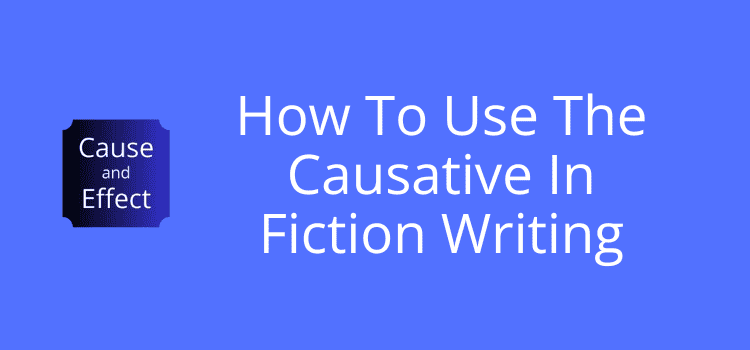
You probably use this structure in your writing occasionally but don’t realize it has a name. It’s the causative.
It lets you show the influence of one character over another, such as for control, persuasion, or cooperation.
While it’s a relatively simple structure, it has many uses and forms that can add extra depth and meaning to your creative or fiction writing.
When used appropriately, it can help you to show, not tell.
What is the causative?
When you use a causative sentence, you say that one person is making another person do something.
It’s not about direct actions but who is causing them.
A direct action sentence might be, “She wrote the report in two hours.”
However, “Her boss made her write the report in two hours.” is causative and changes the cause of the action.
The most common causative verbs are make, have, let, get, and help. You can use them to suit different situations, from encouragement to coercion. Here are some quick examples.
Make: To show authority or force (“She made him apologize for his mistake.”)
Let: To imply permission (“He let her go home earlier than usual.”)
Have: To suggest an arrangement or instruction (“I had him call the client to set up a meeting.”)
Get: To indicate persuasion (“She got him to agree to her plan.”)
Help: To show assistance (“He helped her finish the report on time.”)
The active and passive forms
You can use a causative sentence in active and passive forms, but it works slightly differently from the regular passive voice.
In the active form, the subject makes someone else do something.
For example, “She made him go to the dentist.”
It’s clear that she initiates the action, and he performs it.
For the causative passive form, the focus shifts to the action itself.
For instance: “She had her car serviced.” This sentence doesn’t specify who performed the action, so it’s passive.
The difference between a regular passive voice and a causative passive lies in the intent.
Normal passive voice performs an action on the object (the subject of a passive sentence) without an operator.
Example: “The house was cleaned.”
Causative passive, however, shows the arrangement by someone.
Example: “She had the house cleaned.”
Regular passive focuses on the action only.
With the causative passive, it is always clear who initiated the action, even if the performer of the action is not mentioned.
It’s a choice, but both forms are useful in specific situations.
How to use the causative in fiction writing

You can use the structure in so many ways. It can create tension, hint at manipulation or persuasion, or show the dynamics between characters.
If you have two characters in conflict, you could say, “Mary made George leave,” which is more powerful than “Mary told George to leave,”
For a more positive situation, you might use “Mary got George to stay,” instead of “Mary asked George to stay.” This would move the focus of his reaction to her decision.
Another use is to add a little subtlety to character relationships.
For example, “She let him take the lead” suggests deference or trust, while “She made him take the lead” indicates authority or insistence.
Using your writing skills to include small shifts in wording can improve a scene by adding more depth or complexity.
You could try experimenting with causatives to show more intent, create tension, or reveal character traits.
It’s a very useful tool in storytelling, whether you’re writing action, mystery, romance, or a thriller.
Using the structure to show and not tell
You know the writing advice for fiction: show, don’t tell.
Causatives are perfect for this because you can imply emotions and intentions without spelling them out with long narrative descriptions.
Examples:
He made her laugh. (Shows he has influence over her mood.)
She got him to confess. (Hints at persuasion or cleverness without outright stating it.)
They had the room cleaned before anyone arrived. (Suggests urgency or a need to cover something up.)
When you use causatives, you can make your writing more subtle.
Instead of writing, “She forced him to apologize because she was angry,” you could say, “She made him apologize.”
This lets readers decide on the reasons behind her actions.
You can also use causatives to reveal hidden power struggles.
For example, “He had her remove the evidence” shows control, while “He got her to remove the evidence” hints at persuasion or manipulation.
Minor differences like these can change how readers perceive the interaction.
For building tension in a thriller, instead of writing, “He hired someone to follow her,” you could try, “He had her followed.”
The second version is shorter and more mysterious, keeping readers on edge. The vagueness of who carried out the action leaves much to the imagination.
Causatives can help you avoid over-explaining while showing the emotions and dynamics at play.
Mistakes to avoid
While causatives are incredibly useful, they can trip you up if you’re not careful.
One common mistake is overuse, which can make your writing feel repetitive or overly structured.
Vary your sentence constructions to keep your story engaging.
Another pitfall is failing to match the causative verb to the intended tone or context.
For example, make can sound forceful, so it might not fit a lighthearted or cooperative scene.
Similarly, using get in a formal context could feel out of place.
Always consider the mood and style of your piece when choosing causatives.
Lastly, don’t rely on them to carry your story alone.
It is a tool to enhance your writing, but it’s not a replacement for well-developed characters or plot lines.
Summary
You might think that the causative is a relatively minor grammar structure, but it’s a useful tool for all forms of creative writing.
It can help you show power, persuasion, and relationships in a subtle way.
Whether you are trying to create tension, build character dynamics, or add some nuance, it can help you.
Next time you’re revising a scene, take a moment to think about when a causative sentence might improve the interaction.
Related Reading: When To Use Dialogue Or Reported Speech In Fiction
Share This Article


